January releases from Indicator
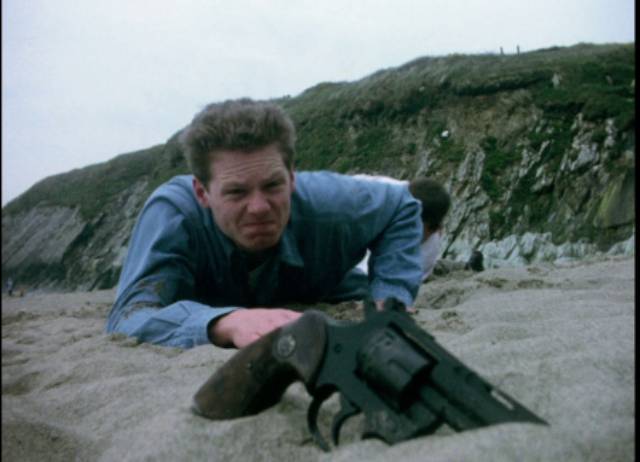
A wide-ranging selection of titles released in meticulous editions have made Indicator one of the top companies in the world since their debut in October 2016, and now they’ve begun the new year with what feels like a personal challenge: Magic, Myth & Mutilation: The Micro-Budget Cinema of Michael J. Murphy 1967-2015 is a ten disk set devoted to a filmmaker I’ve never heard of before, but whose story appeals to me. There’s been a long tradition of amateur filmmaking in the U.K., perhaps the best-known examples being the early work of Peter Watkins, whose short films using documentary techniques to reconstruct recent historical events led to the BBC financing both Culloden (1964) and The War Game (1966), and the ambitious features of Kevin Brownlow and Andrew Mollo: It Happened Here (1964), made while still in their early twenties, and Winstanley (1975). In these cases, amateur passion led to successful careers in the industry – Watkins as a provocative theorist and director (Privilege [1967], Punishment Park [1971], La Commune [2000]), Brownlow as a critic, historian and documentarian, and Mollo as a production designer and consultant specializing in military history.
However, Michael J. Murphy remained in the do-it-yourself realm of amateur production, a passionate film-lover who apparently had a lifelong compulsion to make movies with his friends, beginning in his mid-teens and continuing until just before his death in 2015 at age 63. He started with 8mm, stepped up to super-8 and then 16mm, and eventually worked on video. The filmography included in the set’s accompanying book lists thirty-six movies made over fifty years; gathered on ten disks are twenty-six which have survived in some form, along with fragments of seven others. Unlike the aforementioned Watkins, Brownlow and Mollo, Murphy apparently worked exclusively in the fantasy, horror and thriller genres despite minuscule budgets, and although I haven’t yet dipped a toe into this mass of material, the initial impression I get is of a fringe auteur like Andy Milligan, though perhaps without the dark obsessions. It’s going to be quite a project to tackle the set…
*
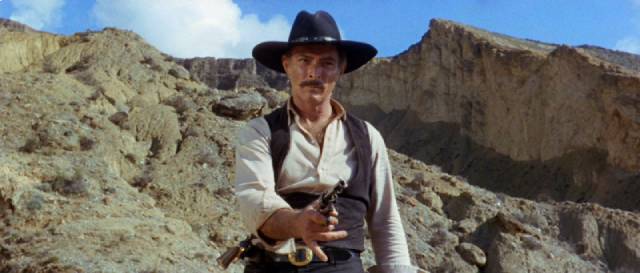
The Big Gundown (Sergio Sollima, 1967)
In the meantime, I have watched the new Indicator edition of The Big Gundown (1967), the first of three spaghetti westerns directed in quick succession by Sergio Sollima. All three starred Tomas Milian, and in this one he’s paired with Lee Van Cleef in his first movie after playing Angel Eyes in The Good, the Bad and the Ugly (1966), cementing his status as an Italian genre icon. Van Cleef is bounty hunter Jonathan Corbett, being groomed for a political career by wealthy businessman Brokston (Walter Barnes). When it’s reported that a Mexican peasant named Cuchillo (Millian) has raped and murdered a twelve-year-old girl, Corbett leaves Brokston’s daughter’s wedding reception to track down the fugitive.
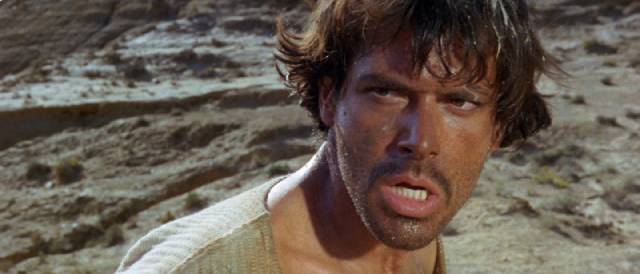
Rambling and episodic, the movie concentrates on moments rather than a tightly structured narrative, with odd asides like a lengthy sequence set on a ranch run by a widow (Nieves Navarro) who likes to see her ranch hands whipped after she has sex with them. Strangely, despite his formidable reputation, Corbett is repeatedly outwitted by Cuchillo, who enjoys mocking him. It’s only as the climax is reached across the border in Mexico that the bounty hunter reveals that he’s had doubts about the peasant’s guilt all along and the identity of the actual killer is revealed during a showdown which exposes racism and class prejudice.
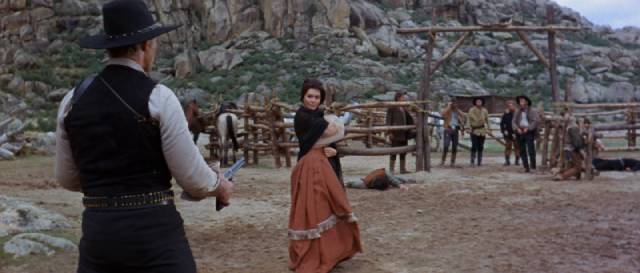
The project began as a story by notable Leftist writer Franco Solinas, which had a contemporary setting and more overt political content; a young policeman is sent after an aging man accused of rape, but even though he discovers that the man is innocent and being framed, he nonetheless kills him in order to secure career advancement for himself. The message about corruption in the Italian establishment was diluted with the transposition of the story to the 19th Century West and the bleak ending was ditched in favour of a more audience-friendly “happy ending” … displeasing Solinas. Perhaps feeling he had leaned too far into commercial compromise, Sollima’s subsequent movies frequently had bleaker, more cynical and even nihilistic endings.
The two-disk set includes three different cuts – the full Italian version (which is the one I watched), the American theatrical (twenty-one minutes shorter) and a slightly longer American video release version – with a couple of commentaries, archival interviews with Sollima and Milian, plus a couple of new featurettes with Stephen Thrower and another with author Austin Fisher, discussing director and star and the position of the movie in the context of the genre.
*
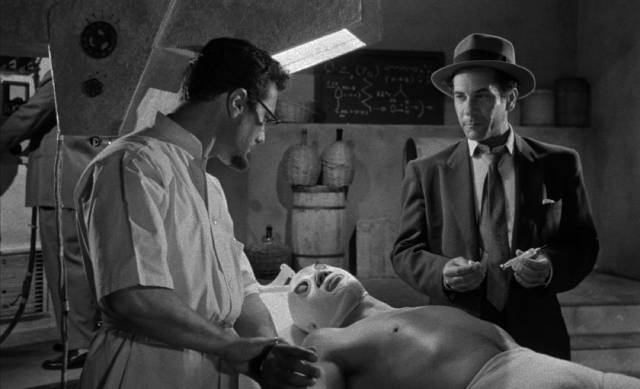
Enter Santo: The First Adventures of the Silver-Masked Man (Joselito Rodríguez, 1961)
Indicator’s other new release is a fascinating look at an odd corner of cinema history. Enter Santo presents the first two features starring the masked wrestler who became a cultural icon in Mexico. I was quite eager to see these since I’d recently watched Vinegar Syndrome’s edition of the much later Santo vs Dr. Death (1973) and was curious about the origins of this distinctly Mexican cultural phenomenon. However, Santo vs Evil Brain and Santo vs Infernal Men (both released in 1961, though shot in 1958) proved quite disappointing. Threadbare productions with barely coherent stories, they’re hardly a showcase for the famous wrestler. In fact, despite his name in the titles, he’s essentially a supporting character with very little dialogue and, most surprisingly, an ill-defined screen persona. The slapdash execution extends to clumsy fight scenes in which El Santo is beaten up way more than he beats the bad guys.
In each movie, he is an agent fighting criminal gangs, though in the first he spends much of the short running-time under the control of the Evil Brain aka Dr. Santos (Joaquin Cordero), a scientist with plans to rule the world through his brain-controlling technology. El Santo lumbers around clobbering his law enforcement colleagues until deprogrammed by another agent, El Incognito (Fernando Osés). In the second movie, the masked agent tackles a more prosaic ring of drug smugglers.
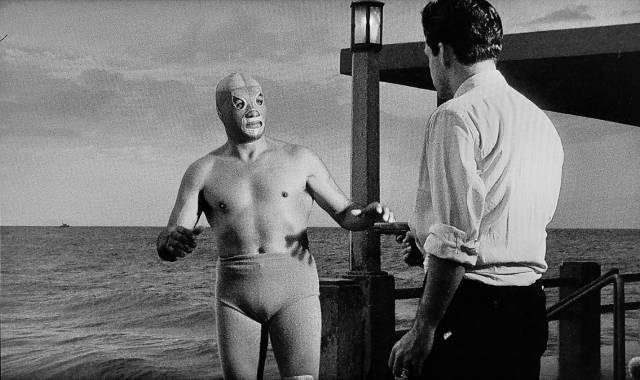
Both movies have a careless, thrown-together feel, amplified by the repetition of entire sequences from Evil Brain in Infernal Men, padding out the running time to get it to a mere seventy-six minutes (compared to the first movie’s seventy-two). In tone and production values, they resemble the kind of thing Edward L. Cahn was making for producer Sam Katzman in the ’50s. But despite this, Indicator’s two-disk set turns out to be a rich source of movie and cultural history.
With almost three hours of documentaries and interviews and an eighty-page book of new and archival essays, the set not only delves into the El Santo movies (around fifty in two-plus decades) as part of a distinctive Mexican genre, and the making of these two in particular, but also into the history of movie-production in Mexico from the ’30s into the ’70s. The set builds on Indicator’s previous releases of La llorona (1933) and Phantom of the Convent (1934), once again with substantial participation from Viviana Garcia-Besné, multiple generations of whose family were involved in Mexican cinema for five decades.
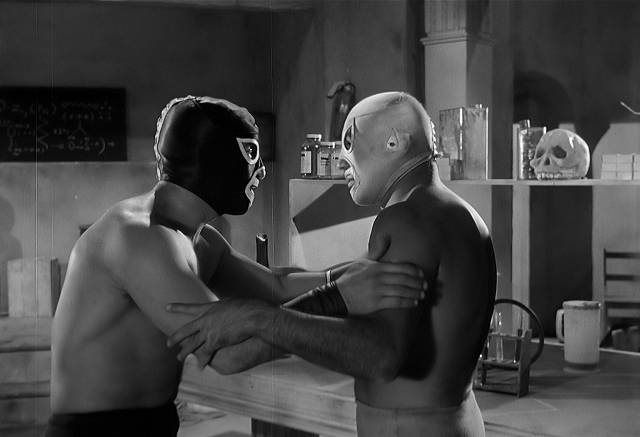
The story of the making of the first two El Santo movies is far more interesting than the movies themselves. Producer Jorge Garcia Besné was struggling by the late ’50s, having alienated his in-laws, the Calderón family, who had gone from exhibition with a large chain of theatres in Mexico and Texas in the ’30s into production to generate a supply of home-grown popular movies to fill their screens. Garcia Besné had married Mate Calderón, sister of producers Pedro, Memo and José Luis, but his chronic infidelity saw him sidelined from the family business. So he came up with a plan to make money on a minimal investment.
He was introduced to El Santo, enormously popular as a luchadore who had first donned his silver mask in 1942, when his persona was that of a rudo, a bad guy in the ring. By the late ’50s, he was one of the most popular of the masked wrestlers, long featured in a comic devoted to his fictional adventures, but being fully committed to his wrestling career he had shown no interest in the movies. Nonetheless, Garcia Besné managed to persuade him to take a chance by starring in a pair of movies to be shot in Cuba, where production would be cheaper than in Mexico.
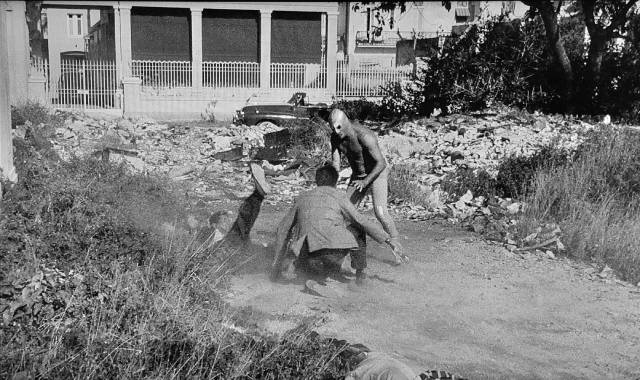
With barely enough money to cover basic costs (in fact, the productions ran out before shooting was completed, with the exposed film held hostage by the lab in Havana), the two movies were shot quickly by Joselito Rodríguez, who had been churning out commercial movies since 1941. There was not enough money or time to do more than grab shots on the fly and move on, probably without permits to film on the streets and beaches of Havana. More significantly, as shooting was underway, Castro’s forces were winning the fight against Batista’s army – in fact, the victorious revolutionaries were entering the city as the crew rushed to get as much in the can as possible before the popular uprising posed too much of a threat to continue. On the plus side, the confusion made it possible for Garcia Besné to grab the material held by the lab without having to pay the bill, and he fled back to Mexico with what he had (concealed inside a coffin!) and proceeded to piece the two movies together as best he could, with release delayed for a couple of years.
Despite this inauspicious beginning, El Santo had realized the potential of the movies and, while continuing his career in the ring, began the parallel career which brought him international success, becoming a kind of superhero/secret agent battling criminals and, more importantly for movie fans, a wide array of monsters and mad scientists, beginning with Santo vs the Zombies and Santo vs the Vampire Women (both 1962).
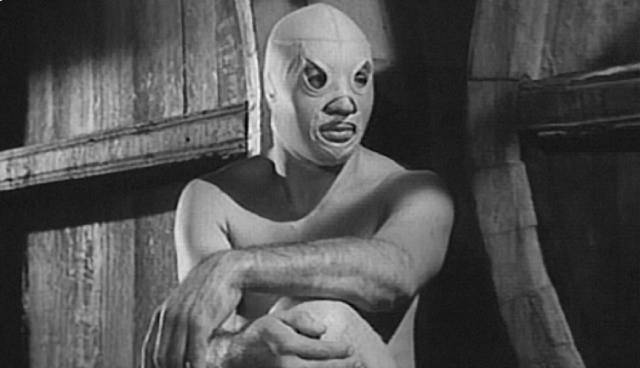
The first disk in the set includes a documentary (31:00) by Vivian Garcia-Besné tracing the Havana locations on which the movies were shot, with elements of family history woven through as she recounts her grandfather’s key role in the productions. Although more than sixty years have passed, it’s interesting to see how many of the films’ locations still exist.
In addition, there’s an archival interview with co-star Joaquin Cordero (12:00), the evil scientist of the first movie and an undercover agent in the second, in which he talks about his friendship with Garcia Besné and working with El Santo. And filling out the disk is a new interview with the Masked Critic (33:00) about the history of lucha libre, the origins of the wrestling movie genre, and the role the movies played in transforming El Santo from a popular sports figure into a national icon.
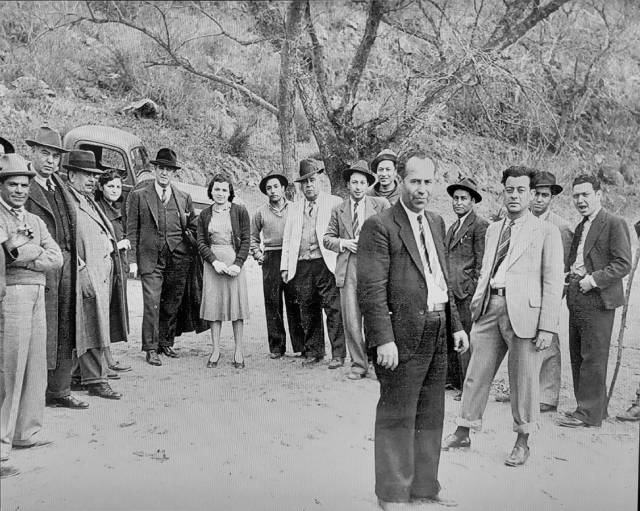
On the second disk, we get Viviana Garcia-Besné’s feature-length documentary Perdida (2011), which combines personal family history with a fascinating account of Mexican national cinema. Starting from a slightly conflicted position, Garcia-Besné explores her grandfather’s and uncles’ role in the less reputable side of movie production, catering to what were considered to be debased popular tastes for melodrama and sex, offensive to “intellectuals” and the Church alike. Along the way, her family encountered the likes of Pancho Villa and gangsters (who eventually used threats and economic pressure to force her great-grandfather to sell his extensive chain of cinemas).
With engaging interviews with her grandmother and great-uncle Pedro Calderón, Garcia-Besné also uncovers sometimes painful details of family history (including her grandmother Mate’s romantic relationship with a young Ricardo Montalban and her father’s refusal to allow her to marry an actor, which was how she ended up with the unfaithful Garcia Besné). As she digs into the family history, uncovering diaries and documents which reveal details about the business, including the unwilling sale of the theatres to those gangsters, the personal elements blend with a larger history, including the family’s influence on popular music and the creation of stars whose success transcended national borders, all culminating in a public attack on the Calderóns and their fellow producers by President Luis Echeverria in the early ’70s.
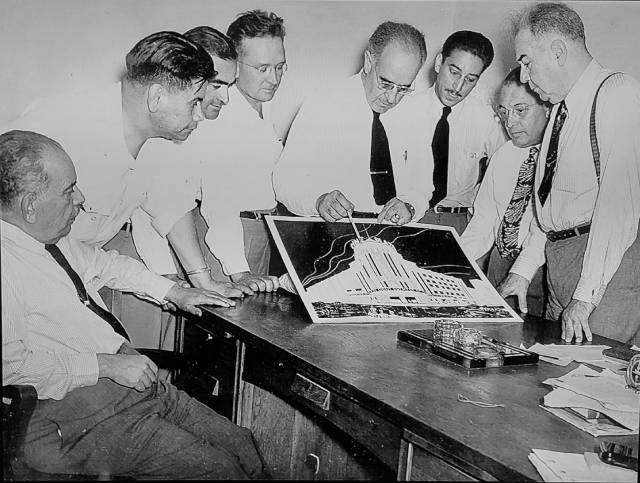
At an event to which all the producers were invited, Echeverria told them all to quit what they were doing and go away because their movies were an embarrassment to Mexico; what was needed were filmmakers who could uplift the culture rather than drag it down. Rejecting this attack, the Calderóns doubled-down by producing Las Ficheras (Beauties of the Night, 1975), a musical melodrama about nightclub hostesses which proved a huge box office success, revitalizing the exploitative genre which the President had railed against.
Towards the end of the documentary, Garcia-Besné steps up her quest to come to terms with the seedier side of the family business. Even back in the ’50s, they had been pushing against the limits of acceptability by including nudity in their movies, provoking censure from the Church and censors. By the late ’60s, movies were being shot in two versions, one for the domestic market, and one for export – the latter including more nudity and sex. Among these productions was an El Santo movie called Santo in the Treasure of Dracula (1969), directed by Rene Cardona, which was reputed to have an alternate version called El Vampiro y El Sexo. The movie’s co-star Aldo Monti, who played Dracula, tells Garcia-Besné in an interview that he doesn’t recall shooting any nude scenes – until she shows him stills in which he’s in a clinch with a bare-breasted actress.
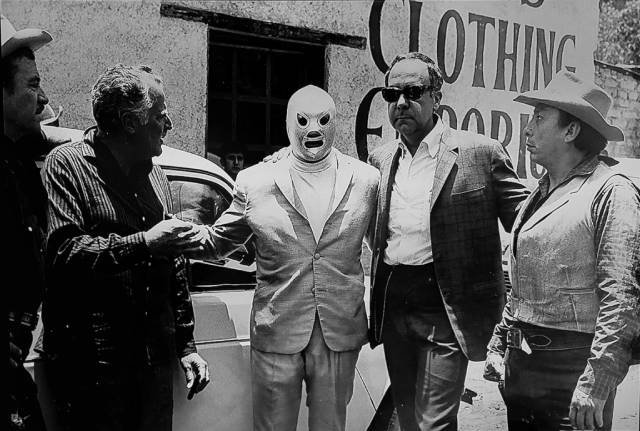
Although previously denied access to the family vault, Garcia-Besné finally gets into a storage room whose shelves are stacked with 35mm film cans among which she eventually discovers all the reels of the racy export version of the movie, which does indeed feature quite a few naked women. What does this say about Mexican cinema, other than that like any other national industry its aim was to sustain itself by appealing to the tastes of the largest possible audience? … and that as elsewhere there was a place for enterprising people like the Calderón family who for decades did just that, delivering entertainment and exploitation with a distinctive local flavour which also appealed beyond Mexico’s borders.
Perdida is a dense, entertaining and informative blend of personal reminiscence and cultural history which ties the filmmaker’s family to the rise and decline of the 20th Century’s most popular art form, which for me is particularly poignant in its account of the disappearance of the Calderóns’ chain of opulent movie palaces; Garcia-Besné visits sites which once entertained large audiences but are now empty lots or repurposed buildings, or most sadly mere shells collapsing in decay. While the two Santo features have limited intrinsic interest, this documentary and the other extras make the set essential for anyone interested in the history of cinema.
Comments